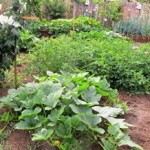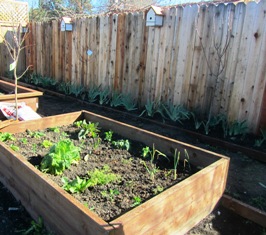Helping a Kitchen Garden to Grow in Clay Soil
Under the searing summer sun, the clay soil of my farmette will grow amazing pin oaks, white oaks, and pine trees. But for a gardener like me who wants to grow vegetables and herbs, clay soil frustrates and challenges.
Before planting next year’s kitchen garden in a new area of the property, I’ll have to change the soil structure now. This will take time and a lot of effort, but it will pay huge dividends over the long term.
Here are a few things things a gardener can do to improve clay soil.
1. A few weeks before working an area, mulch the area with an eight to ten-inch layer of wood chips to help the soil retain moisture and regain structure.
2. Use a pickax to break up the soil to the depth of 10 inches and work in composted organic material.
3. Avoid working the soil after a rain or when the ground is wet because the soil will ball up into unwieldy clumps.
4. Work in sand or perlite to create more pore space for aeration and drainage. Beware of adding too much sand; the soil becomes like concrete. Ideally, the soil should have roughly fifty percent pore space with minerals and organic matter filling in the rest.
5. When not growing plants, sow a cover crop of legumes to reduce weed germination, prevent erosion, and help water penetrate deeply into the soil. A legume cover crop provides plant matter that can be turned back into the soil or mowed, leaving the plant’s bio mass in place. Legumes fix the nitrogen in the soil that will nourish the plants of the kitchen garden.
6. Repeat all of the above steps annually and dig, turn, rake, and water. Over time, the soil should support healthy roots of plants and give you a robust kitchen garden that will provide many tasty vegetables and culinary herbs.
____________________________________________________________________
If you enjoy reading cozy mysteries and are interested in gardening/farming topics, keeping bees and chickens, or creating delicious recipes from heirloom vegetables and herbs, check out my Henny Penny Farmette series. All are available from Amazon, Barnes and Noble, and other traditional and online bookstores everywhere.
Coming 9/27/17
PUBLISHERS WEEKLY 08/14/2017 noted:
“Lester’s sensitive portrayal of Abby’s struggle with her wounded psyche raises this traditional mystery above the pack.”
See more at: https://www.barnesandnoble.com/w/a-hive-of-homicides-meera-lester/1125424538?type=eBook
Organic Amendments to Benefit Soil
There are many ways to improve soil composition to grow healthy plants. Healthy plants produce more abundant and bigger yields.
The soil on the Henny Penny Farmette is mostly heavy clay. After a rain, its sticks together like solid, cold mass of margarine. In the summer, it hardens like concrete and also cracks.
To make soil more porous, it is necessary to add amendments that permit air circulation and water penetration and retention.
There are basically two different types of amendments. The mineral amendments such as vermiculite, pumice, and perlite are generally used in sandy soil to create aeration and water retention. Types of organic amendments for soil such as our clay soil include manure, leaf mold, ground bark, peat moss, and sawdust. These rely on bacterial action to break down into a soft, crumbly humus.
In our vegetable growing boxes that are 4 feet by 6 feet, we include 25 percent organic amendments to 75 percent soil. Sometimes we even up the percentage of amendment material. We turn it thoroughly.
The clay soil immediately benefits from the tilling (adding air) and also from the blending of organic material into the soil to change its density, nutrient value, and permeability to water.
Raised beds, which I first saw on farms in villages along the Volga in Russia, allow us to control the soil and makes it easier to add amendments and mulch. However, we also have garden beds, too, that benefit from organic amendments.
 Facebook
Facebook Goodreads
Goodreads LinkedIn
LinkedIn Meera Lester
Meera Lester Twitter
Twitter









